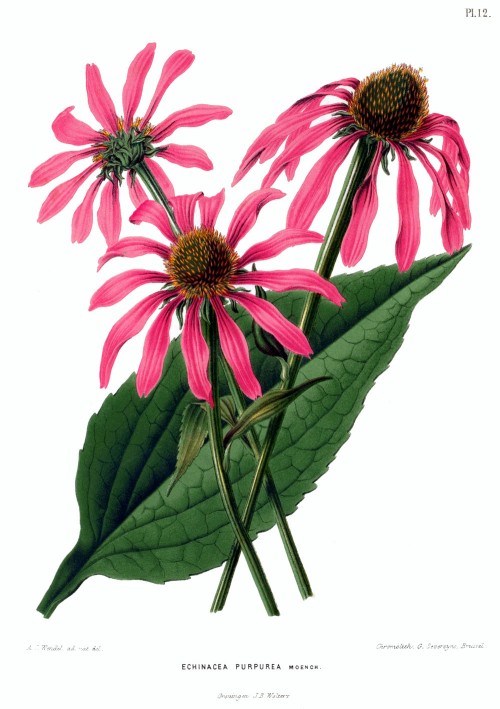Echinacea purpurea (L.) Moench. - syn. Brauneria purpurea (L.) Britton; Rudbeckia purpurea L. - Asteraceae
eastern purple-coneflower, purple-coneflower, Purpurfarbener Sonnenhut, Purpurfarbene Kegelblume, Purpursonnenhut, Roter Scheinsonnenhut
Perennial herb, up to 120cm high, native to central North America, naturalized and cultivated as ornamental and herbal remedy; stems usually brownish green; leaves ovate to narrowly lanceolate, margins usually serrate to dentate, rarely entire; paleae 9-15mm, tips red-orange, sharp-pointed; ray corollas pink to purple, laminae spreading to recurved, up to 8cm long; discs corolla lobes greenish to pink or purple; cypselae off-white, 3.5-5mm. http://www.efloras.org/florataxon.aspx?flora_id=1&taxon_id=220004561
Alkamides (dodecatetraenoic acid isobutylamides) content in Echinacea purpurea preparations, prepared from expressed juice, ranged from 0.1 to 1.8 mg/ml. „The content of cichoric acid varies more dramatically (0.0-0.4%) likely due to inconsistent inhibition of the enzymatic degradation of cichoric acid.“
[Standardization of Echinacea purpurea expressed juice with reference to cichoric acid and alkamides., Bauer, R., Journal of herbs, spices & medicinal plants, 6(3), 1999, 51-62]
The fresh plant juice, dried whole herb (Echinaceae purpureae herba), and roots (Echinaceae purpureae radix) are used „… in supportive treatment of colds and inections of the respiratory and unrinary tract; externally to treat wounds, ulcers, and skin inflammations… Immune stimulant properties are ascribed to the polysaccharides but the amides and caffeic acid derivatives also contribute to antimicrobial and anti-inflammatory effects in alcoholic extracts.“
[Medicinal Plants of the World. Ben-Erik Van Wyk and Michael Wink, Pretoria 2004, 130]
The E. purpurea tincture Echinaforce(TM) „… induced de novo synthesis of tumor necrosis factor α (TNF-α) mRNA in primary human monocytes/macrophages, but not TNF-α protein. Moreover, LPS-stimulated TNF-α protein was potently inhibited in the early phase but prolonged in the late phase. A study of the main constituents of the extract showed that the alkylamides dodeca-2E,4E,8Z,10E/Z-tetraenoic acid isobutylamides (1/2), trienoic (3) and dienoic acid (4) derivatives are responsible for this effect. The upregulation of TNF-α mRNA was found to be mediated by CB2 receptors, increased cAMP, p38/MAPK and JNK signaling, as well as NF-κB and ATF-2/CREB-1 activation.“
[Echinacea alkylamides modulate TNF-α gene expression via cannabinoid receptor CB2 and multiple signal transduction pathways., Gertsch, J., Schoop, R., Kuenzle, U., Suter, A., FEBS letters, 577(3), 2004, 563-569] http://www.sciencedirect.com/science/article/pii/S0014579304013183
E. purpurea root reportedly contains 0.01–0.04% alkamides, mainly isobutylamides of straight-chain fatty acids with olefinic and/or acetylenic bonds. „Isobutylamides from the roots of E. purpurea contain mainly 2,4-dienoic units, while those of E.angustifolia contain mainly 2-monoene units.
In-vitro experiments with human macrophages found that fresh pressed juice and dried juice from the aerial parts of E. purpurea stimulated production of cytokines, including interleukin (IL)-1, IL-10, and tumour necrosis factor (TNF-α) (Burger et al 1997). Other studies have reported that purified polysaccharides from E. purpurea induced macrophage production of IL-1 (Stimpel et al 1984), and that a polysaccharide arabinogalactan isolated from plant cell cultures of E. purpurea induced TNF-α and interferon-β2 production by murine macrophages (Luettig et al 1989). Polysaccharides obtained from plant cell cultures of E. purpurea have also been shown previously to have immunological activity in-vitro (Wagner et al 1988). In another series of in-vitro experiments, E. purpurea induced macrophage activation (as assessed by TNF-α production) following simulated digestion (incubation of echinacea with gastric fluid) in an attempt to mimic effects following oral administration (Rininger et al 2000).“
[Echinacea species (Echinacea angustifolia (DC.) Hell., Echinacea pallida (Nutt.) Nutt., Echinacea purpurea (L.) Moench): a review of their chemistry, pharmacology and clinical properties., Barnes, J., Anderson, L.A., Gibbons, S., Phillipson, J.D., Journal of Pharmacy and Pharmacology, 57(8), 2005, 929-954]
„While there are some hints that both alcoholic extracts and pressed juices that are based primarily on the aerial parts of E. purpurea have beneficial effects on cold symptoms in adults, the evidence for clinically relevant treatment effects is weak. There are still many remaining doubts due to the fact that not all trials using such preparations show even a trend towards an effect.“
[Karsch-Voelk, M., Barrett, B., Kiefer, D., Bauer, R., Ardjomand-Woelkart, K., & Linde, K. (2014). Echinacea for preventing and treating the common cold. Cochrane Database Syst Rev, 2.] http://www.ncbi.nlm.nih.gov/pmc/articles/PMC4068831/

Witte, H., Flora. Afbeeldingen en beschrijvingen van boomen, heesters, éénjarige planten, enz., voorkomende in de Nederlandsche tuinen, p.45, t.12 (1868) [A.J.Wendel]
http://plantgenera.org/species.php?id_species=368745
Echinacea purpurea
© Rolf Marschner (2011),
www.botanische-spaziergaenge.at
